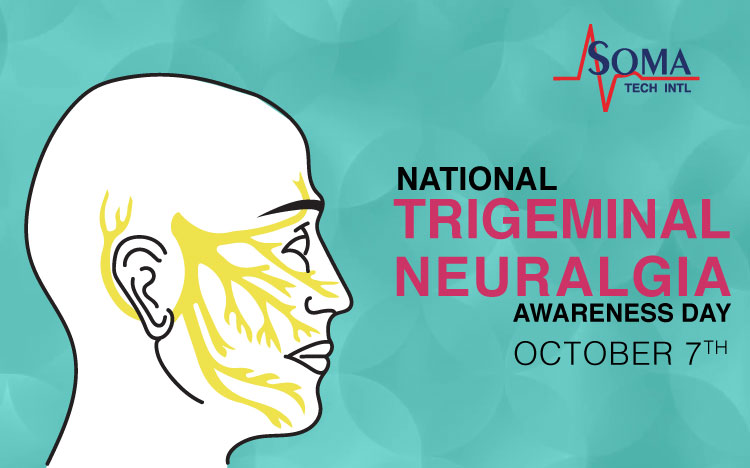National Trigeminal Neuralgia Awareness Day | October 7th
October 7, 2020
National Trigeminal Neuralgia Awareness Day
October 7th
Today Soma would like to help raise awareness and help educate people about Trigeminal Neuralgia (TN). This is a rare condition where you have pain associated with your trigeminal nerve. The trigeminal nerve is the fifth cranial nerve also referred to as CN V. This nerve is responsible for sensation in the face and motor functions like chewing. The trigeminal nerve is the most complex cranial nerve in the human body. Continue reading to learn more about the trigeminal nerve and trigeminal neuralgia.
More About The Trigeminal Nerve
The Trigeminal nerve consists of 3 main sections; the Ophthalmic nerve, the maxillary nerve, and the mandibular nerve. The Ophthalmic nerve branches out and provides sensory innervation to the eye and upper part of the face. The Maxillary nerve provides sensation from the maxilla, nasal cavity, sinuses, and palate. The Mandibular nerve is the largest section of the trigeminal nerve and is responsible for sensory functions, around the mandible. This includes the lower lip and stretches all the way back from your cheek, the auricle of the ear, and part of the temple.
Trigeminal Neuralgia
Trigeminal neuralgia, also called tic douloureux, is a chronic pain condition where even mild stimulation of your face may trigger pain. It’s a form of neuropathic pain, which is pain associated with a nerve, like a nerve injury or nerve lesion. At first, you may experience short pain attacks but as it progresses it can cause longer and more frequent pain.
What Causes Trigeminal Neuralgia?
TN can be caused by a blood vessel pressing on the trigeminal nerve as it exists in the brain stem. The compression caused by this nerve can cause damage to the protective layer around the nerve. Trigeminal neuralgia can also be caused as the result of an injury to the face or sinus or any surgery that could cause damage to the trigeminal nerve. TN is a rare condition affecting about 12 per 100,000 people per year. Everyone’s symptoms are different but the most common symptoms of TN are below.
Symptoms of Trigeminal Neuralgia
Some symptoms of TN include:
- Severe pain in the face or top of the head
- Attacks of pain triggered by touching the face, chewing, or speaking
- Constant aching and burning feeling before the severe spasm of trigeminal neuralgia
- Pain affects one side of the face at a time, and rarely affects both sides at the same time.
Final Thoughts
If you are experiencing facial or head pain for a long period of time, recurring pain, or pain that doesn’t go away from over-the-counter medication you should schedule an appointment with your doctor. Help raise awareness for trigeminal neuralgia with the hashtags #TNAwarenessDay and #FaceTodayTogether.
2 comments
Leave a Reply
Explore Other Blog Items By Category
Recent Posts


EKG vs ECG | What’s the Difference Between ECG and EKG?


I was diagnosed with TN March 2021. I had another flare up in October 21. I’m Match 2022 I had more attacks and again, this October 2022. Is TN seasonal?
Hello Heidi!
Thank you for reading! We would recommend contacting your doctor. They will better be able to answer this question.
Soma Tech Intl